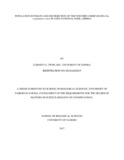| dc.description.abstract | The western chimpanzee (Pan troglodytes verus) has recently been uplisted from endangered to “Critically Endangered category” in the IUCN Red List. It is therefore key to monitor population status and trends of the remaining chimpanzee populations in the region, which is frequently done by counting sleeping nests of individuals along line transects. In tropical forests, permanent line transects can facilitate the passage of surveyors, but may also cause avoidance by animal species, which complicates data analysis and may yield erroneous estimates. In this study, surveys were conducted in Liberia’s Sapo National Park (SNP) and its buffer zone along clear-cut (‘permanent’) and uncut (‘temporary’) line transects to estimate chimpanzee abundance and compare chimpanzee densities inside and outside the park and determine the impact of human activities on the survival of the chimpanzees. All indirect signs of chimpanzee presence and human activities were recorded on 16 permanent transects in SNP and six temporary transects within the surrounding buffer zone. The analysis of this study revealed a population density of 0.83 individuals/ km2 (CV= 0.29) across the park and its buffer zone. Compared to previous estimates, this suggests a relatively stable population of roughly 1,000 chimpanzees over the past eight years and represents 15% of the total population of about 7000 chimpanzees in Liberia. Despite the presence of human threats in and outside the park, it appears that poaching and habitat encroachment, which has been persisting in the area since the first chimpanzee survey in 2009, did not have a significant negative affect on population growth over time. Possible reasons for this include the existence of local taboos against killing chimpanzees, poachers not targeting chimpanzees directly, and chimpanzee behavioral flexibility. Nest encounter rate inside the park was considerably lower than in the buffer zone and significantly fewer nests were found on or near permanent transect lines (19%) than temporary transects (44%), indicating an avoidance effect of chimpanzees towards the former. The study also shows that permanent transects were frequently used as passageways by illegal miners and poachers, providing direct evidence of the impact that humans have on chimpanzee habitat use and the potential negative implications of cutting permanent transect lines on wildlife in the park. There is a need for an increase in conservation and law enforcement efforts to prevent humans from accessing the park. Furthermore, it is also necessary for the legal enforcement of the park’s buffer zone in order to effectively protect wildlife against poaching, habitat destruction and disease, and ensuring the continued survival of chimpanzees in Liberia’s oldest national park.
Keywords: Chimpanzees, hunting, Sapo National Park, line transect, buffer zone, conservation planning | en_US |



